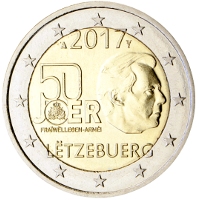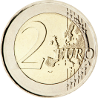 |
C o m m e m o r a t i v e
C o i n s |
||
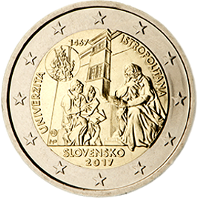 🔎
🔎 |
 |
Slovakia | 04 Jan. 2017 | 550th anniversary of the start of teaching at the Universitas Istropolitana |
20001 20002 20005 |
1,000,000 |  |
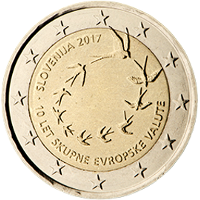 🔎
🔎 |
 |
Slovenia | 02 Feb. 2017 | 10th anniversary of the adoption of the Euro in Slovenia |
20001 20002 20005 |
1,000,000 |  |
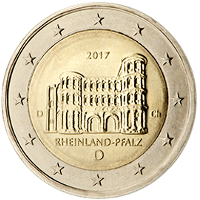 🔎
🔎 |
 |
Germany | 03 Feb. 2017 | Rhineland‐Palatinate (Porta Nigra in Trier) 12th coin in the Federal States series |
20001 20002 20005 |
30,616,300 |  |
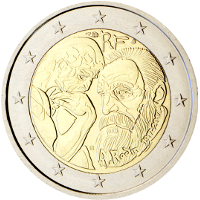 🔎
🔎 |
 |
France | 03 Feb. 2017 | Centenary of the death of Auguste Rodin |
20001 20002 20005 |
10,020,500 |  |
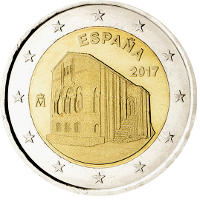 🔎
🔎 |
 |
Spain | 03 Feb. 2017 | Monuments of Oviedo and the Kingdom of Austurias (Santa Maria del Naranco) 8th coin in the UNESCO World Heritage Sites series |
20001 20002 20005 |
536,520 |  |
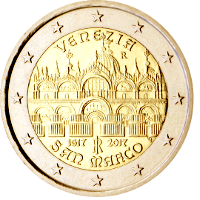 🔎
🔎 |
 |
Italy | 22 Mar. 2017 | 400th anniversary of the completion of the Basilica San Marco in Venice |
20001 20002 20005 |
1,500,000 |  |
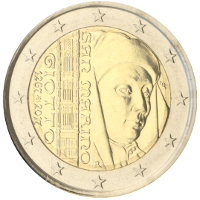 🔎
🔎 |
 |
San Marino | 30 Mar. 2017 | 750th birthday of Giotto |
20001 20002 20005 |
73,100 |  |
 🔎
🔎 |
 |
Belgium | 21 Apr. 2017 | 200 years University of Liège |
20001 20002 20005 |
200,000 |  |
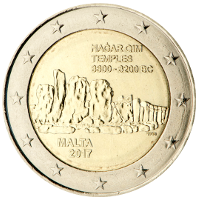 🔎
🔎 |
 |
Malta | 31 May 2017 | Tempel of Ħaġar Qim 2nd coin of the Maltese Prehistoric Sites series |
20001 20002 20005 |
405,000 |  |
 🔎
🔎 |
 |
Finland | 01 Jun. 2017 | 100 years of independence |
20001 20002 20005 |
2,500,000 |  |
 🔎
🔎 |
 |
Vatican City | 01 Jun. 2017 | 1950th anniversary of the martyrdom of Saint Peter and Saint Paul |
20001 20002 20005 |
98,000 |  |
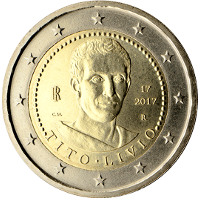 🔎
🔎 |
 |
Italy | 23 Jun. 2017 | Bimillenary of the death of Titus Livius |
20001 20002 20005 |
1,500,000 |  |
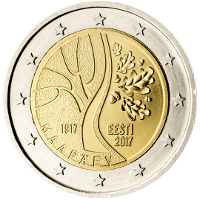 🔎
🔎 |
 |
Estonia | 26 Jun. 2017 | Estonia's road to independence |
20001 20002 20005 |
1,500,000 |  |
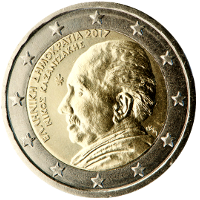 🔎
🔎 |
 |
Greece | 10 Jul. 2017 | 60 years since the death of Nikos Kazantzakis |
20001 20002 20005 |
750,000 |  |
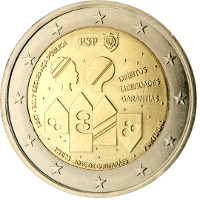 🔎
🔎 |
 |
Portugal | 13 Jul. 2017 | 150 years of Public Security (PSP) |
20001 20002 20005 |
520,000 |  |
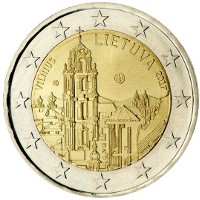 🔎
🔎 |
 |
Lithuania | 31 Aug. 2017 | Vilnius ‐ City of Culture |
20001 20002 20005 |
1,000,000 |  |
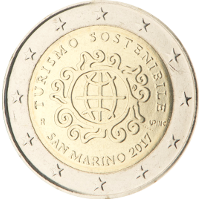 🔎
🔎 |
 |
San Marino | 31 Aug. 2017 | International year of Sustainable Tourism |
20001 20002 20005 |
73,100 |  |
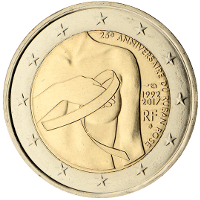 🔎
🔎 |
 |
France | 25 Sep. 2017 | 25 years of Breast cancer awareness |
20001 20002 20004 20005 |
10,020,500 |  |
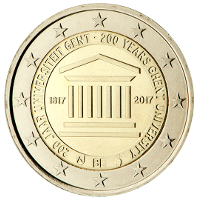 🔎
🔎 |
 |
Belgium | 29 Sep. 2017 | 200 years Ghent University |
20001 20002 20005 |
225,000 |  |
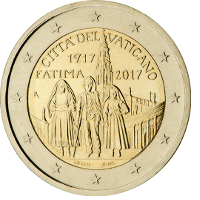 🔎
🔎 |
 |
Vatican City | 05 Oct. 2017 | Centenary of the Fátima apparitions |
20001 20002 20005 |
98,000 |  |
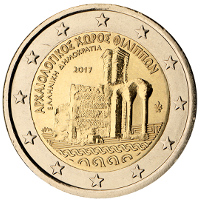 🔎
🔎 |
 |
Greece | 12 Oct. 2017 | Archaeological site of Philippi |
20001 20002 20005 |
750,000 |  |
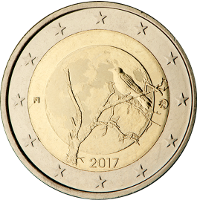 🔎
🔎 |
 |
Finland | 23 Oct. 2017 | Finnish Nature |
20001 20002 20005 |
500,000 |  |
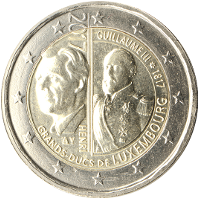 🔎
🔎 |
 |
Luxembourg | 26 Oct. 2017 | 200th birthday of the Grand Duke Guillaume III. 18th coin of the Grand-Ducal Dynasty series |
20001 20002 20005 |
311,000 |  |
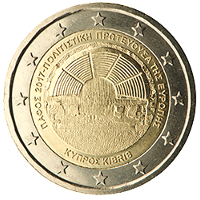 🔎
🔎 |
 |
Cyprus | 03 Nov. 2017 | Paphos - European Capital of Culture 2017 |
20001 20002 20005 |
430,000 |  |
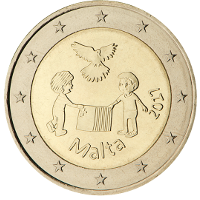 🔎
🔎 |
 |
Malta | 13 Nov. 2017 | Solidarity and Peace 2nd coin of the from children in solidarity series |
20001 20002 20005 |
380,000 |  |
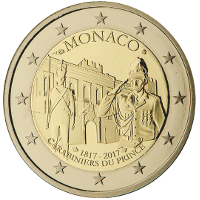 🔎
🔎 |
 |
Monaco | 13 Nov. 2017 | 200 years Compagnie des Carabiniers du Prince (Carabiniers' of the Prince) |
20001 20002 20005 |
15,000 |  |
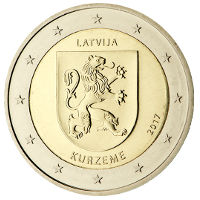 🔎
🔎 |
 |
Latvia | 14 Nov. 2017 | Kurzeme (Courland) 2nd coin of the Historical Regions series |
20001 20002 20005 |
500,000 |  |
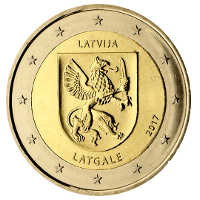 🔎
🔎 |
 |
Latvia | 14 Nov. 2017 | Latgale 3rd coin of the Historical Regions series |
20001 20002 20005 |
500,000 |  |
 🔎
🔎 |
 |
Portugal | 21 Nov. 2017 | 150. Geburtstag Raul Brandäos |
20001 20002 20005 |
520,000 |  |
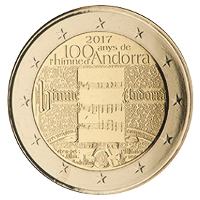 🔎
🔎 |
 |
Andorra | 08 Feb. 2018 | 100th anniversary of the Andorran anthem |
20001 20002 20005 |
85,000 |  |
 🔎
🔎 |
 |
Andorra | 08 Feb. 2018 | Andorra ‐ the Pyrenean country |
20001 20002 20005 |
85,000 |  |
| ⇓ 2018 ⇓ |
| References : | |||
| 20001 | Images taken with authorisation by the ECB - Mail dated 20.Feb.2020 © "European Central Bank" |
20002 | Data mirrored from Wikipedia Page "2_euro_commemorative_coins" with friendly support of the guardians of that page. |
| 20003 | Not Applicable | 20004 | Coloured version of this Commemorative Coin in circulation EU-legal-technical specifications do not recongnise colour prints, but the EU is tolerate them, due to the facts that their numbers are very small and that they are sold in special packs and therefor are very unlikely to be used as currency. |
| 20005 | enlarged Images taken with authorisation by Gerd Seyffert © "Gerd Seyffert 2021" |
20006 | Not Applicable |
 |
